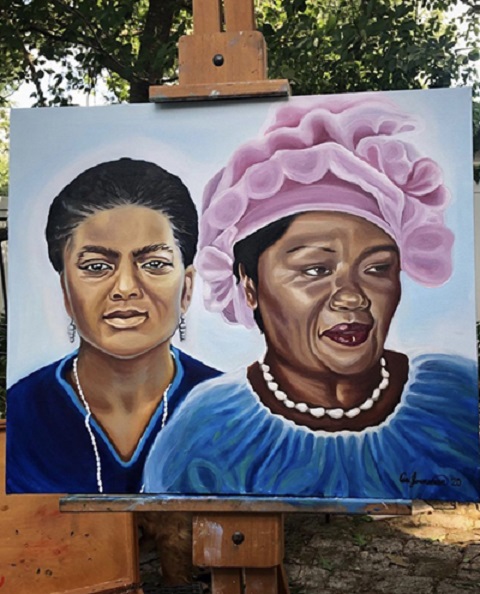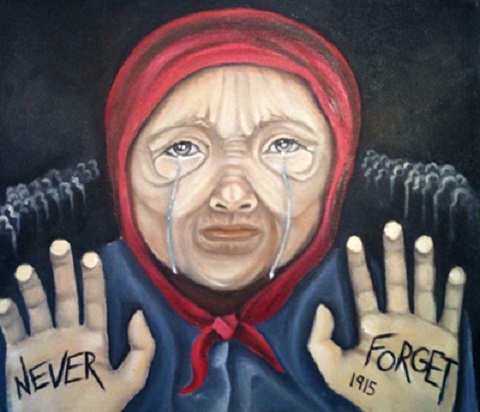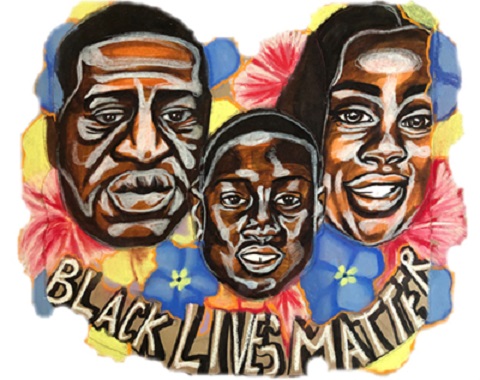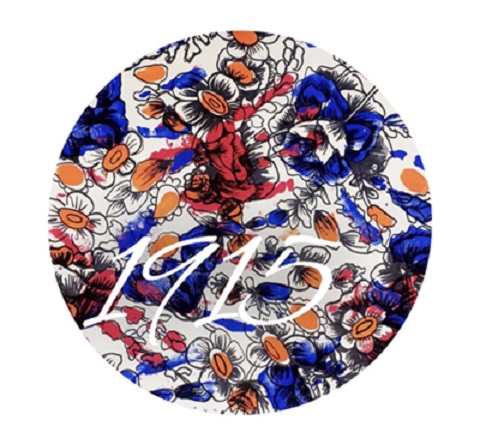SPRINGFIELD, Mass. — Ani Jermakian is a talented young artist with a cause: making people’s lives better through her artwork.
She says, “the motive of art is healing.”
The 23-year-old native of the Wilbraham, a suburb of Springfield, has a positive attitude and a sweet, caring personality that immediately comes across. She has tackled very serious issues in her work, from the Armenian Genocide to the Black Lives Matter movement with her project #Illbeyourvoice. By profession, she is an art teacher who has dedicated her career to nurturing the next generation in the public school system.
Jermakian, a third-generation Armenian-American who comes from a close-knit family heavily involved in the Armenian community (particularly at St. Mark’s Armenian Church in Springfield), started private art lessons at age 8. Her elementary school teachers noticed that she had a serious talent for art, and informed Jermakian’s mother, who found her a private teacher, Donald Blanton. Blanton, a prominent artist in Springfield, is especially known for his work with children and youth in teaching art. Jermakian took lessons from ages 8 to 18 and still keeps in touch.
“He nurtured my talent,” she said. “He taught me things like looking at something and practicing your eye — it’s super important.” Her sharp eye for the world around her led naturally to Jermakian’s adoption of a Realist style.
Unlike many contemporary artists, Jermakian’s work tends toward realism and portraiture. “I was taught classical art,” she said, by Blanton, noting than an early inspiration was Americana realist painter Norman Rockwell. But perhaps the most important reason is that it helps her connect with the people that are going to be enjoying her works.
“I feel like it’s more relatable. I get a lot of commissions for portraits. And I feel that the person is commissioning me because they want a painting [that they can enjoy],” she noted.
Jermakian employs her own style of brushwork to draw out the expression in the painting. Her portraiture, which is realist but in a modern way and with Jermakian’s own flair, somewhat reminds one of the work of Frida Kahlo (minus the surrealist aspect) and her husband Diego Rivera. She adds, “I enjoy flowing, rounded lines, where everything is smooth and calming.
Armenian Roots and ‘I’ll Be Your Voice’
“Armenian stuff has been my go-to since high school,” Jermakian says.
For an AP Art class, she was required to put together a portfolio; she chose the Armenian Genocide as a theme and created 10-12 pictures. They had to be “super realistic,” she says, because they had to tell the true story of what happened. “I had to show the human body. I wanted it to be real, and my skills were portraiture and realism.” She adds that the more creative aspect came in “changing the backgrounds and manipulating [light and color] to show how devastating it was.” Some of the paintings did include symbolism which was not quite realistic in content, but realistic in style. “I painted a woman with her hands up at the front of the scene, as if she is pushing up against glass and can’t escape,” Jermakian says. “I always had the mantra that I’m the voice of my ancestors. They can’t speak and talk about what happened to them now because they’ve passed on, but I can tell their story.”
When the racial justice movement of the summer of 2020 began, Jermakian felt that her Armenian heritage compelled her to stand up for Black lives. “I was noticing everyone was talking about it online, but Armenians not so much. We don’t talk about this as much as we should and it bothers me. I started thinking about our identity.” Jermakian pointed out that though she was raised to consider herself “white,” her fellow students in college did not consider her white, based on her dark Armenian complexion and ethnic features. “They used to try to guess what I was, Hispanic, half-black half-white…I told them I’m Armenian and we’re considered white, but everyone was like ‘Oh, you can’t be white.’”
Jermakian’s parents were surprised when she came home with this information. Generations of Armenians who have been born and raised in the US, particularly on the East Coast, have been classified as white by society for many years. Yet many millennial Armenians, particularly with a darker complexion, are not considered white by their peers — a change that Jermakian attributes to the fallout of 9-11, when Middle Eastern ethnicities were held in greater suspicion throughout the country.
“We think of ourselves as white, but others say we aren’t. That got the wheels turning about how we think of ourselves. We are marginalized in our own way.”
Jermakian noted that while many or most Armenians in US benefit from white privilege, certainly Armenians were an oppressed ethnicity in other countries in the past — particularly in Ottoman Turkey, and in today’s Republic of Turkey. If Armenians have been persecuted, then “we should be speaking up” about racial injustice, Jermakian argued. “We are connected to our suppressed past. And advocacy isn’t just about advocating for your own group. You can advocate for things that don’t affect you.”
Jermakian began to think about ways to take a stand in support of the Black Lives Matter movement, as an outgrowth of her advocacy for her own people throughout her high school and college years when she would always educate others on the Armenian Genocide. Jermakian has another deeply personal reason to support the movement. Her teacher and mentor Blanton, is Black.
“When I was 15-16 I painted a picture of a black woman,” Jermakian said. She noted it wasn’t necessarily a specific person, but represented the beauty of Black people with whom she felt a connection because of her teacher.
“In college I used that picture in every class,” she said.
Jermakian felt compelled to do portraits of “the three most prominent victims of police brutality,” George Floyd, Ahmaud Arbery, and Breonna Taylor, in order to “celebrate that person’s face.” “I actually got some backlash for it, like I shouldn’t be using their images or painting their faces. But I’m an artist. Everyone talks about ‘say their name,’ but I think of faces, it’s my way of saying their name.” Whatever her detractors were accusing her of, Jermakian was not using these images for personal gain. Instead, she initiated what she calls the #IllBeYourVoiceProject. Taking a cue from friends, she had her artistic images of the victims along with her idealized image of black female beauty printed on stickers and T-shirts. She sells these items and all proceeds go to the cause – specifically the Center for Racial Justice in Education (“I wanted to support them because I’m a teacher”) and the Black Lives Matter (BLM) organization.
When the war broke out in Artsakh, she added the Armenian cause to her “I’ll Be Your Voice Project.” Her website delineates how she relates the two causes and that of oppressed people everywhere. She wrote: “Armenians can be visually racially ambiguous people — often being mistaken for other ethnicities. However, we now live in a country where we are protected under white privilege because our skin color is agreeable to the majority. We need to use this privilege and heavily impactful voices as white-identifying people to speak up and be loud. Now is the time to spread the love that we live by in our faith for which we were once persecuted. If we are so passionate about the injustice that happened to our people, we need to be passionate about the injustice that is happening in front of our eyes today.” For the Armenian-themed stickers and T-shirts, she uses designs and artwork that she did in high school relating to the Genocide and Armenian culture. The proceeds from these products go to Armenia Fund. She also donated some of the proceeds to her parish’s fundraiser for Artsakh, which raised $1,500 that was then matched by another organization.
For the rather small Springfield community, that was a lot. Ani is proud of her contributions to both causes.
A Sensitive Portraitist
Aside from her philanthropic/human rights activity and her teaching, Jermakian’s biggest calling card is her portrait painting, which also appears on both of her websites, and is also imbued with the spirit of helping people tell their stories – helping to be their voice.
“In high school I started doing portraits and when I showed them to people, I started getting requests. A lot of it was from family and church members, Armenians.” But this past year, as schools were closed down due to Covid, Jermakian found portrait painting as an alternative way to gain some income. “I wasn’t employed so I didn’t have anything to do. All my portraits are also posted on Instagram, so that leads to more commissions.” Over the summer, Jermakian had a sale – $20 per portrait. “That’s really cheap, way less than what anyone charges to paint a portrait.” But it helped kick off interest in her work. Then she got a very special commission. Someone who found her via Instagram wanted a picture done of his two grandmothers. The family, who live in Worcester, are immigrants from Cameroon.
“He wanted a picture of the two foundations of the family,” says Jermakian, and it was important to the grandson because his grandmothers are getting up in years. He sent Jermakian a photograph. “I really loved the picture,” she said. “I got a vision of a huge painting. The colors were what was in the photo.”
The portrait became Jermakian’s passion project over the summer. “I was due for a big project, and this took me all summer.” Just as with her approach to most of her art, she wanted to help the family tell their story. She regrets not knowing more about the two women. “Both are from Cameroon, and one of them had 8 kids.” She added, “It meant a lot to me. I was invested in telling the story of these women; capturing the story through their eyes.”
Jermakian worked hard on the women’s eyes in the portrait. “The eyes can draw you into the painting. They seemed like such powerful women and pillars of the family and I felt I had to do them justice. There was strength in their eyes. And I had to paint them as real eyes, looking at you.”
Ani Jermakian’s artwork, created with love, will always serve the purpose of making people’s lives better – whether in her career as a teacher, her uplifting the voice of the oppressed, or her telling the story of everyday people through her sensitive, glowing portraiture. As she says, “the motive of art is healing.”
To see her work, visit www.artworkbyani.com or her Instagram account which is also titled Artwork By Ani.
Main Photo Caption: Artist Ani Jermakian





























































